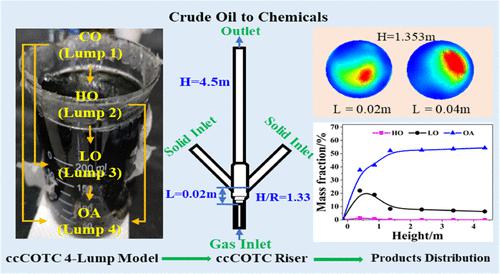当前位置:
X-MOL 学术
›
Ind. Eng. Chem. Res.
›
论文详情
Our official English website, www.x-mol.net, welcomes your
feedback! (Note: you will need to create a separate account there.)
Simulation of Hydrodynamics of the Riser Reactor for Catalytic Cracking of Crude Oil to Chemicals
Industrial & Engineering Chemistry Research ( IF 3.8 ) Pub Date : 2023-03-23 , DOI: 10.1021/acs.iecr.3c00034 Feng Wang 1, 2, 3 , Hui Wang 2, 3 , Nianming Jiao 2 , Maoming Gong 2, 3 , Xiangping Zhang 2, 3, 4
Industrial & Engineering Chemistry Research ( IF 3.8 ) Pub Date : 2023-03-23 , DOI: 10.1021/acs.iecr.3c00034 Feng Wang 1, 2, 3 , Hui Wang 2, 3 , Nianming Jiao 2 , Maoming Gong 2, 3 , Xiangping Zhang 2, 3, 4
Affiliation

|
Direct catalytic cracking of crude oil to chemicals (ccCOTC) has become the development trend in the petrochemical industry. A riser is one of the key reactors in a ccCOTC process. In this work, a two-fluid model (TFM) was used to simulate a relationship between the reactor geometry and gas–solid flow in a typical riser (inside diameter of 17 mm and height of 4.5 m) established in our laboratory, with the aim of improving chemical yield and optimizing the reactor geometry in a ccCOTC process. The effects of key geometric parameters, including the angle between an oblique pipe for catalyst return and the vertical riser (α), the distance between the nozzle orifice and catalyst return oblique pipe (L), the ratio of height to diameter in the prelifting zone (H/D), and the number of catalysts returning to oblique pipes (n), on the distribution of catalyst particles and product profiles were studied. An optimized reactor geometry was proposed according to the index of gas–solid dispersion evenness. To further know the effect of the riser geometry on the product distribution, the two-fluid model (TFM) coupled with a four-lumped kinetic model was used to predict the cracking product profiles along the riser axial. It was found that the ccCOTC riser can remarkably enhance the yield of target chemicals (C2–C4 olefins, benzene, toluene, and xylene), which was approximately 3.1% higher than the result from the pilot test (using the riser before geometry optimization). This work could provide fundamental support on the design of a reactor to maximize light olefins and monocyclic aromatic hydrocarbons in the ccCOTC process.
中文翻译:

原油催化裂化制化学品提升管反应器流体动力学模拟
原油直接催化裂化制化学品(ccCOTC)已成为石化行业的发展趋势。立管是 ccCOTC 工艺中的关键反应器之一。在这项工作中,双流体模型 (TFM) 用于模拟我们实验室建立的典型提升管(内径 17 mm,高度 4.5 m)中反应器几何形状与气固流动之间的关系,其中旨在提高 ccCOTC 工艺中的化学收率和优化反应器几何形状。催化剂回流斜管与立管夹角α、喷嘴孔距催化剂回流斜管距离L、预升区高径比等关键几何参数的影响(高/深), 以及返回斜管的催化剂数量 ( n), 对催化剂颗粒的分布和产物分布进行了研究。根据气固分散均匀度指标提出了优化的反应器几何结构。为了进一步了解冒口几何形状对产物分布的影响,使用双流体模型 (TFM) 与四集中动力学模型相结合来预测沿冒口轴向的裂化产物分布。结果发现,ccCOTC 提升管可以显着提高目标化学品(C2-C4 烯烃、苯、甲苯和二甲苯)的收率,比中试(使用几何优化前的提升管)的结果高出约 3.1% . 这项工作可以为在 ccCOTC 工艺中最大化轻质烯烃和单环芳烃的反应器设计提供基础支持。
更新日期:2023-03-23
中文翻译:

原油催化裂化制化学品提升管反应器流体动力学模拟
原油直接催化裂化制化学品(ccCOTC)已成为石化行业的发展趋势。立管是 ccCOTC 工艺中的关键反应器之一。在这项工作中,双流体模型 (TFM) 用于模拟我们实验室建立的典型提升管(内径 17 mm,高度 4.5 m)中反应器几何形状与气固流动之间的关系,其中旨在提高 ccCOTC 工艺中的化学收率和优化反应器几何形状。催化剂回流斜管与立管夹角α、喷嘴孔距催化剂回流斜管距离L、预升区高径比等关键几何参数的影响(高/深), 以及返回斜管的催化剂数量 ( n), 对催化剂颗粒的分布和产物分布进行了研究。根据气固分散均匀度指标提出了优化的反应器几何结构。为了进一步了解冒口几何形状对产物分布的影响,使用双流体模型 (TFM) 与四集中动力学模型相结合来预测沿冒口轴向的裂化产物分布。结果发现,ccCOTC 提升管可以显着提高目标化学品(C2-C4 烯烃、苯、甲苯和二甲苯)的收率,比中试(使用几何优化前的提升管)的结果高出约 3.1% . 这项工作可以为在 ccCOTC 工艺中最大化轻质烯烃和单环芳烃的反应器设计提供基础支持。










































 京公网安备 11010802027423号
京公网安备 11010802027423号